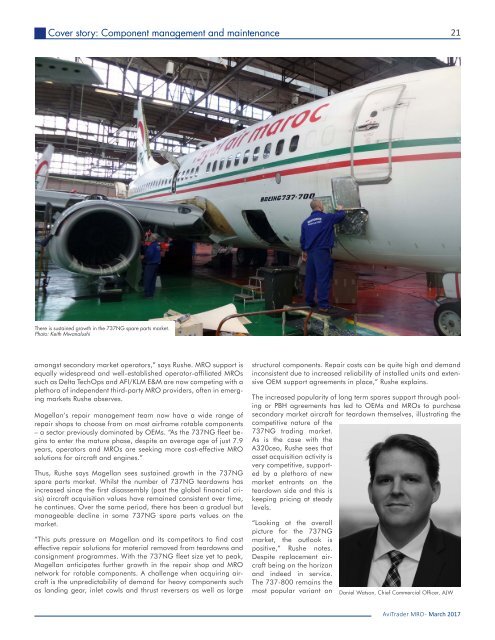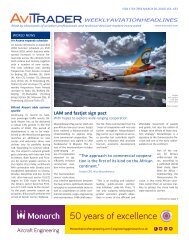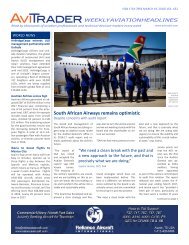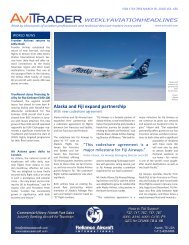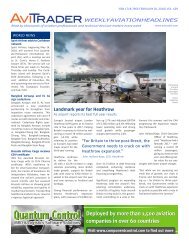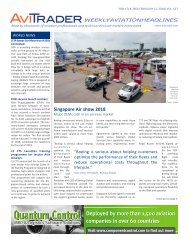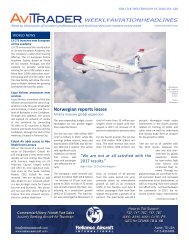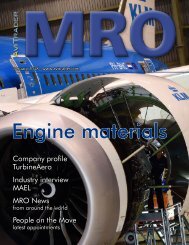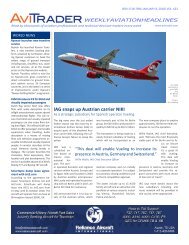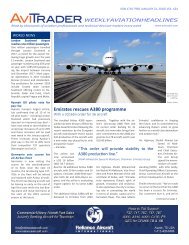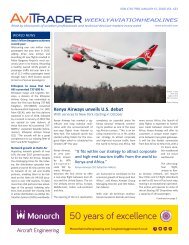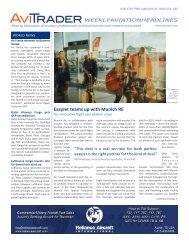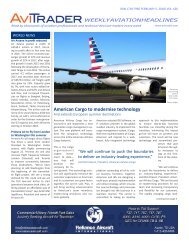AviTrader MRO Magazine 2017-03
AviTrader MRO Magazine 2017-03
AviTrader MRO Magazine 2017-03
You also want an ePaper? Increase the reach of your titles
YUMPU automatically turns print PDFs into web optimized ePapers that Google loves.
Cover story: Component management and maintenance<br />
21<br />
There is sustained growth in the 737NG spare parts market.<br />
Photo: Keith Mwanalushi<br />
amongst secondary market operators,” says Rushe. <strong>MRO</strong> support is<br />
equally widespread and well-established operator-affiliated <strong>MRO</strong>s<br />
such as Delta TechOps and AFI/KLM E&M are now competing with a<br />
plethora of independent third-party <strong>MRO</strong> providers, often in emerging<br />
markets Rushe observes.<br />
Magellan’s repair management team now have a wide range of<br />
repair shops to choose from on most airframe rotable components<br />
– a sector previously dominated by OEMs. “As the 737NG fleet begins<br />
to enter the mature phase, despite an average age of just 7.9<br />
years, operators and <strong>MRO</strong>s are seeking more cost-effective <strong>MRO</strong><br />
solutions for aircraft and engines.”<br />
Thus, Rushe says Magellan sees sustained growth in the 737NG<br />
spare parts market. Whilst the number of 737NG teardowns has<br />
increased since the first disassembly (post the global financial crisis)<br />
aircraft acquisition values have remained consistent over time,<br />
he continues. Over the same period, there has been a gradual but<br />
manageable decline in some 737NG spare parts values on the<br />
market.<br />
“This puts pressure on Magellan and its competitors to find cost<br />
effective repair solutions for material removed from teardowns and<br />
consignment programmes. With the 737NG fleet size yet to peak,<br />
Magellan anticipates further growth in the repair shop and <strong>MRO</strong><br />
network for rotable components. A challenge when acquiring aircraft<br />
is the unpredictability of demand for heavy components such<br />
as landing gear, inlet cowls and thrust reversers as well as large<br />
structural components. Repair costs can be quite high and demand<br />
inconsistent due to increased reliability of installed units and extensive<br />
OEM support agreements in place,” Rushe explains.<br />
The increased popularity of long term spares support through pooling<br />
or PBH agreements has led to OEMs and <strong>MRO</strong>s to purchase<br />
secondary market aircraft for teardown themselves, illustrating the<br />
competitive nature of the<br />
737NG trading market.<br />
As is the case with the<br />
A320ceo, Rushe sees that<br />
asset acquisition activity is<br />
very competitive, supported<br />
by a plethora of new<br />
market entrants on the<br />
teardown side and this is<br />
keeping pricing at steady<br />
levels.<br />
“Looking at the overall<br />
picture for the 737NG<br />
market, the outlook is<br />
positive,” Rushe notes.<br />
Despite replacement aircraft<br />
being on the horizon<br />
and indeed in service.<br />
The 737-800 remains the<br />
most popular variant on<br />
Daniel Watson, Chief Commercial Officer, AJW<br />
<strong>AviTrader</strong> <strong>MRO</strong> - March <strong>2017</strong>


